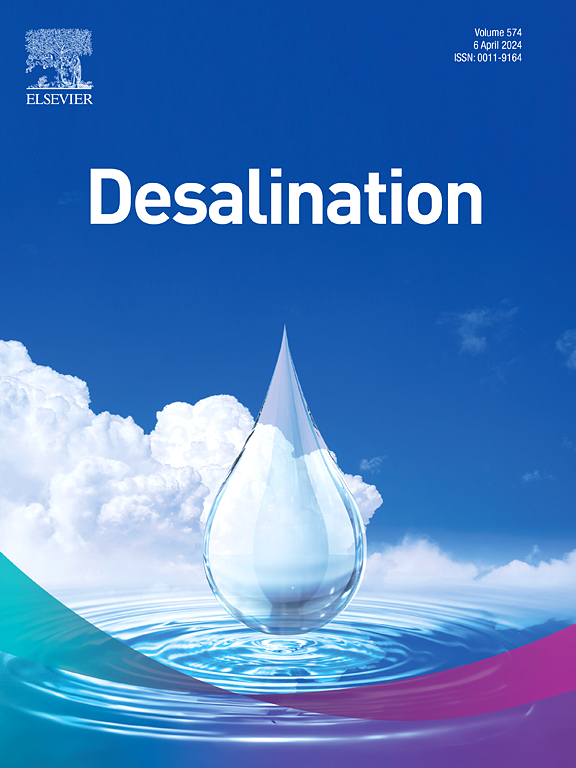Network engineering of elongated bent titanate nanotubes / cross-linked network poly(vinyl alcohol) composite membranes for pervaporation desalination
IF 9.8
1区 工程技术
Q1 ENGINEERING, CHEMICAL
引用次数: 0
Abstract
Mixed matrix membranes incorporating nanotubes has garnered significant attention for efficient separation application. However, there exist several challenging bottlenecks that necessitate addressing to fabricate high-performance membranes, such as poor interfacial compatibility between the polymer matrix and fillers, and issues pertaining to aggregation. Herein, we propose a strategy for synthesizing nanoarchitectures using titanate nanotubes (TNTs). By integrating elongated bent TNTs, we successfully synthesized high performance poly(vinyl alcohol) (PVA) nanocomposite membranes (cPVA-TNTs) featuring a three-dimensional cross-link network architecture. The impact of TNTs on the morphology and structure of the PVA-TNTs nanocomposite membranes was investigated utilizing ATR-FTIR, SEM, and XRD techniques. Due to their well-designed structure, the cPVA-TNTs membranes exhibited significantly enhanced flux and selectivity in pervaporation desalination. The improvement is attributed to the uniform distribution of elongated bent TNTs, improved crosslinking of membrane, and unique porous architecture providing highly efficient ion diffusion and transport channels. Specifically, the membrane containing 1.5 wt% TNTs was incorporated into the cPVA-TNTs membrane system achieved a water flux of 5.65 kg·m−2·h−1 and salt rejection of 99.95 % when desalinating a 3.5 wt% sodium chloride solution at 40 °C. Overall, this rationally designed synthesis route holds great promise for promoting applications of nanotubes to improve membrane performance for pervaporation desalination.

渗透蒸发脱盐用伸长弯曲钛酸盐纳米管/交联网络聚乙烯醇复合膜的网络工程
纳米管混合基质膜在高效分离方面的应用备受关注。然而,要制造高性能的膜,还需要解决几个具有挑战性的瓶颈,比如聚合物基体和填料之间的界面兼容性差,以及与聚集有关的问题。在此,我们提出了一种利用钛酸盐纳米管(tnt)合成纳米结构的策略。通过整合细长弯曲的tnt,我们成功合成了具有三维交联网络结构的高性能聚乙烯醇(PVA)纳米复合膜(cpva - tnt)。利用ATR-FTIR、SEM和XRD等技术研究了tnt对pva - tnt纳米复合膜形貌和结构的影响。由于其良好的结构设计,cpva - tnt膜在渗透蒸发脱盐中表现出显著增强的通量和选择性。这种改进归功于细长弯曲tnt的均匀分布,膜交联的改进,以及独特的多孔结构提供了高效的离子扩散和运输通道。具体来说,将含有1.5 wt% tnt的膜掺入cpva - tnt膜体系中,当3.5 wt%氯化钠溶液在40°C下脱盐时,水通量为5.65 kg·m−2·h−1,盐去除率为99.95%。综上所述,这种合理设计的合成路线对于促进纳米管在渗透蒸发脱盐中改善膜性能的应用具有很大的前景。
本文章由计算机程序翻译,如有差异,请以英文原文为准。
求助全文
约1分钟内获得全文
求助全文
来源期刊

Desalination
工程技术-工程:化工
CiteScore
14.60
自引率
20.20%
发文量
619
审稿时长
41 days
期刊介绍:
Desalination is a scholarly journal that focuses on the field of desalination materials, processes, and associated technologies. It encompasses a wide range of disciplines and aims to publish exceptional papers in this area.
The journal invites submissions that explicitly revolve around water desalting and its applications to various sources such as seawater, groundwater, and wastewater. It particularly encourages research on diverse desalination methods including thermal, membrane, sorption, and hybrid processes.
By providing a platform for innovative studies, Desalination aims to advance the understanding and development of desalination technologies, promoting sustainable solutions for water scarcity challenges.
 求助内容:
求助内容: 应助结果提醒方式:
应助结果提醒方式:


